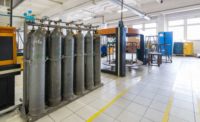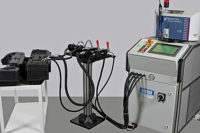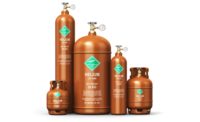As far as origin stories go, the technology behind helium leak detection is more glamorous than most. That is, when compared to the bubble test, a method many will remember experimenting with during childhood after a popped bicycle tire.
The mass spectrometer, which measures helium by atomic weight during a leak test, was developed during the Manhattan Project in the 1940s for testing nuclear weapon production. But it wasn’t until 1966 that the first commercially available helium leak detector appeared—the ASM 4, developed in France by the Alcatel vacuum group, which is now a division of Pfeiffer Vacuum.
From its origins in Oppenheimer’s nuclear program, through France in the ‘60s and now to today, helium leak detection has become a sensitive, precise and quantitative method for evaluating leaks in automotive parts, air conditioning and refrigeration systems and medical devices.
Today, there are three basic methods for helium leak detection, all of which use a mass spectrometer to identify helium escaping through leaks, typically smaller than 10-3sccs. Most commonly used in the automotive industry are automatic leak test systems, where a part is placed under a vacuum hood, and then charged with helium. Any helium that escapes from the part is identified by the mass spectrometer in the vacuum. Another method is essentially the inverse, where the inside of a part is evacuated, and then helium is sprayed on the outside of the part. A spectrometer inserted into the part identifies if helium enters the workpiece. The third method is a sniffer test, often used in the HVAC industry, in which the gas is sent into the part, and a technician manually uses a sniffer to detect if and where helium escapes.
To learn more about trends in the industry, Quality spoke with Dave Morris, product manager for helium and hydrogen leak detection at Pfeiffer Vacuum; and Thomas Parker, automotive market sales manager for Inficon.
QUALITY: How has helium leak testing changed in recent history?
DAVE MORRIS: There is an increasing demand for leak detection due to new requirements in regards to safety, environmental protection, and functionality. One major example is the automotive industry and the introduction of the new Euro 5 standards. Fuel-relevant components must now be tested more stringently than before. Other components such as airbag igniters, which are safety-relevant, are highly dependent for lifelong operation of the vehicle on being leak tight to stringent specifications.
Other markets with similar trends in regards to tighter leak standards are refrigeration and air conditioning components and systems, aviation fuel tanks and medical devices such as implants, etc.
What are the benefits of choosing helium leak detection over bubble testing, compressed air, etc.?
MORRIS: The major benefit of helium leak detection (HLD) testing is higher sensitivity in comparison to other technologies. It can be easily automated and is not operator dependent. In cases where the higher sensitivity of a HLD is not needed, it can also offer other major benefits; one example is faster cycle time. This is true for leak testing itself, but also in regards to the total process time and cost. As an example, a water bath test often requires that the product has to be thoroughly dried before moving to the next step in the process, adding time and energy costs. In addition these visual tests are often operator dependent. Other common test techniques, including pressure decay, can have inaccuracies due to fluctuations in temperature, component flexibility and loss of sensitivity due to part volume, etc.
As an additional benefit, HLD can be used for integral global testing and to locate the position of the leak.
What trends have you seen in helium leak testing?
MORRIS: HLD manufacturers are always trying to reduce the cycle time with better signal processing. In addition, improving sensitivity and algorithms that predict leaks faster are always a focus point of development.
Even though the current high sensitivity is seldom needed, a higher sensitivity of the sensor allows a lower helium concentration to be used and can therefore save costs and resources. As sensitivity increases, accumulation testing without the use of vacuum chambers can reduce costs for applications where high sensitivity is not required.
Of the three major markets (automotive, HVAC/refrigeration and medical), where do you see the biggest growth?
THOMAS PARKER: The big growth is in automotive. You have some companies that choose to helium leak test automatic transmissions. You have some companies that still rely on air testing or bubble testing for transmissions. So we see the auto industry kind of commonizing how the industry tests parts like transmissions.
So in years to come I feel that everybody will be testing automatic transmissions in the same ways, not just a few car companies. Also, with the migration of electric vehicles, lithium ion batteries and autonomous vehicles that are going to be loaded up with sensors and cameras that need to be water-tight, the auto industry provides for a lot more growth. The technology in the automotive industry is changing much more rapidly than say the refrigeration and air conditioning industry.
How is that growth in auto driven by regulations and safety standards?
PARKER: If you look at legislation to increase fuel efficiency above 50 miles per gallon, if you look at CO2 and greenhouse gas reduction initiatives, it’s driving people to use high-pressure fuel systems. And when you go from regular fuel injectors at 80 psi, to injection systems that operate at 2,000-4,000 psi, that level of leak detection just got that much greater.
So, the technology movement is forcing tighter leak specification to satisfy emissions, fuel economy and safety too. When you’ve got autonomous vehicles, you’ve got to ensure that the break sensors and collision sensors and radar sensors are water tight. There’s a big concern that if sensors fail in an autonomous vehicles you’ve got a liability. But who’s at fault? So there’s a lot on the line with this little sensor that probably costs less than a dollar.
What do you see in the air-conditioning and refrigeration market?
PARKER: I’m not going to bring politics into this, but if you look at the administration the last eight years, there’s been a focus on reducing the environmental global warming impact and a lot of initiatives to drive the refrigeration and air conditioning industry to natural refrigerants. And natural refrigerants are things like propane and isobutene. They’re flammable refrigerants, and they satisfy a lot of EPA protocols, SNAP protocols, Montreal protocols, a lot of government initiatives to make meaningful impacts on the environment. Everybody is very patient and waiting to see what the new administration is going to do. Are they going to continue the process to move people away from (global-warming potential) refrigerants to these natural refrigerants? Will the administration say “stop all that stuff, you can continue to use gasses like 134a, 404a or 410?” So the political climate impact on the HVAC industry is huge right now, because that pushes the migration of natural flammable refrigerants. So we’ll all just have to wait and see if that’s going to continue. Or, I can give you my personal opinion. If you’re Honeywell and DuPont, and you make billions of dollars a year selling refrigerant gasses like 134a and 404a, are you just going to let your business die and let gasses like propane and isobutene, which don’t have a lot of profit margin and value-added, are you just going to let those take over the industry? But the political climate and the influence that has on the HVAC industry in my mind is going to be a big buzz.
How do you see the market responding to the rising price of helium?
MORRIS: A quote to start here, “When people talk about the world running out of helium – it’s not. It’s total fiction,” Phil Kornbluth said in September 2016 at the Global Helium Summit 2.0 in New Jersey. Indeed there was an increase in helium pricing in the last 15 years, but what is also important to note is, that after putting into effect the KATAR 2 source in 2013 the prices have been reducing by approximately 20 percent. However, as detectors make more use of sophisticated software algorithms helium concentration can be reduced and still able detect the small leaks specified without impacting the cycle time. Helium recovery is always an option if viable for high usage operations.
PARKER: Three or four years ago there was concern in the helium gas industry of supply. Prices started to get high and people were coming to us saying “can we leak test with a safe hydrogen-nitrogen mix? Can we use argon? Can we get away from helium? Can we reduce the amount of helium concentration that we use with higher-sensitivity leak detectors?” So three or four years ago we went through a phase where we were helping people use less helium, and adjusting their recipes or providing them with more sensitive leak detectors. We also have a family of hydrogen leak detectors that use a safe hydrogen-nitrogen mix, 5 percent hydrogen and 95 percent nitrogen. But those applications are limited to big leaks. So we went through a phase where the industry was asking for something else. Now I’m not hearing any supply issues. Right now the price of helium is favorable so we're not working on those projects like we were four years ago.
Interviews were edited for length and clarity.





